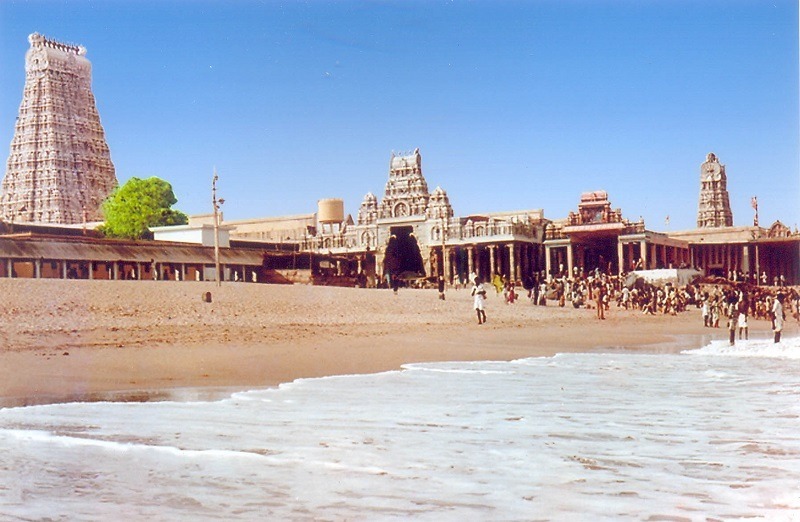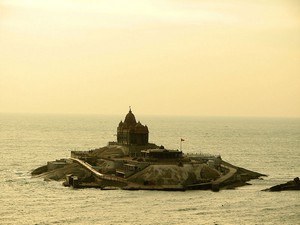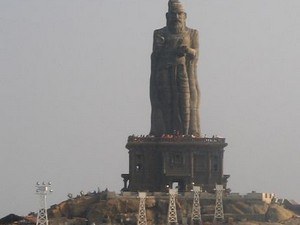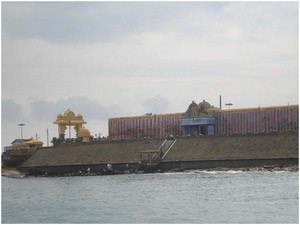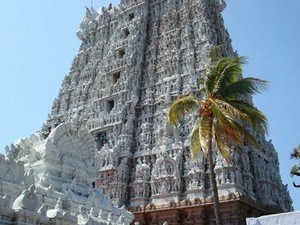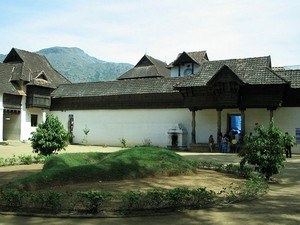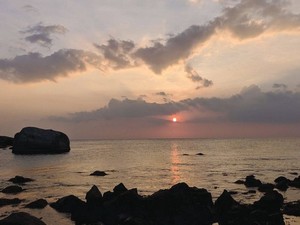Thiruchendur, Kanyakumari - Timings, Festivals, History, Darshan, Pooja Timings
Photo Credit: Flickr
 #10 of 35 Places to Visit in Kanyakumari
#10 of 35 Places to Visit in Kanyakumari
 Distance (From Kanyakumari): 92 Kms
Distance (From Kanyakumari): 92 Kms
 Trip Duration (Including Travel): 4 Hours/Half Day
Trip Duration (Including Travel): 4 Hours/Half Day
 Transportation Options: Bus / Cab
Transportation Options: Bus / Cab
 Travel Tips: None
Travel Tips: None
About Thiruchendur
At a distance of 59 Km from Tirunelveli, 35 Km from Tuticorin and 92 Km from Kanyakumari, Thiruchendur is a small coastal town in the Toothukudi district of Tamil Nadu and is a popular pilgrimage sites in Tamil Nadu. Situated in the Gulf of Mannar, the town is home to the Arulmigu Subramaniya Swamy Temple. This temple is the second among the six Padai Veedu (Battle Camps) of Lord Murugan, the others being Thiruparamkundram, Palani, Swamimalai, Thiruthani and Pazhamudhircholai. It is one of the shrines of the Vaippu Sthalams sung by Tamil Shaivite Nayanar Appar.
History of Thiruchendur
The earliest evidence of the temple's existence can be traced back to inscriptions from 875 AD. While there is no concrete documentation regarding the original construction of the Thiruchendur Murugan Temple, it is acknowledged that the Pallavas, along with subsequent dynasties such as the Pandyas and Cheras, undertook renovations during that period. The Murugan temple at Thiruchendur was occupied by the Dutch East India Company from 1646 to 1648, during the course of their war with the Portuguese. The Dutch finally vacated the temple on orders from the Naik ruler. However, while leaving they looted several idols. According to legend, the Murugan idol was taken aboard their ship, but a sudden storm prompted the Dutch to fear for their safety, leading them to cast the idol into the sea. Vadamalaiyappa Pillai, a devoted follower of Lord Muruga, experienced a vision revealing the idol's location in a dream. He promptly went to the site and discovered a floating lemon, with Garuda flying above. The idol was ultimately retrieved from the depths of the sea at that very location in 1653. This narrative is depicted in paintings within the temple.
Mythology of Thiruchendur
Thiruchendur is referenced in the Skanda Puranam, which narrates the defeat of the demon Surapadman by Lord Murugan. According to Hindu mythology, Surapadman, the demon king, received powerful boons from Lord Shiva after performing intense penance. With this newfound strength, he began to dominate the world. He married Padumakomalai and had several sons, establishing his capital in a city called Viramkendiram, built in the sea. His reign was marked by turmoil as he harassed the devas (gods), even imprisoning Indra, the king of the gods, and coveting Indra's wife, Indrani. In desperation, Indra sought assistance from Murugan, the son of Shiva and the god of war. Murugan dispatched his messenger, Viravakutevar, to confront the demon, but Surapadman remained unyielding. A fierce battle ensued in Thiruchendur, resulting in Murugan's victory, where he vanquished all of Surapadman's sons except for Iraniyan. Surapadman took refuge beneath the sea, but Murugan ultimately defeated him by splitting him in two, transforming the pieces into his divine mounts, the peacock and the rooster. The day of Surapadman's defeat is commemorated as the Skanda Sashti festival in all Murugan temples. Prior to and following the battle, Murugan camped along the Bay of Bengal's shoreline, and after the conflict, he sought to worship Lord Shiva and receive his blessings. Consequently, the architect Mayan constructed a shrine at the site of the current temple, which is one of the six sacred abodes of Lord Murugan in Tamil Nadu and the only one situated by the sea.
Things to do in Thiruchendur
Situated on the shores of the Bay of Bengal, Thiruchendur is celebrated for its historical importance and stunning scenery. Central to Tiruchendur is the Subramanya Swamy Temple, an ancient and esteemed pilgrimage destination dedicated to Lord Murugan. The temple's main entrance is oriented to the south, while the sanctum itself faces east. The impressive 133-foot Rajagopura, located near the Bay of Bengal, exemplifies Dravidian architectural style. This Gopura features nine stories, topped with nine Kalasas. Notably, it is the only Murugan temple positioned along the coastline.
Within the temple, Lord Murugan is depicted in various forms, with the primary deity being Balasubramanya in a standing position. Other representations include Shanmugar, Jayanthinathar, and Kumaravidanga Perumal. The temple comprises two expansive enclosures. Next to the sanctum is the Panchalingam shrine, designed like a cave, where it is believed that Subramanian venerates Lord Shiva. The Senthilaandavar shrine, also adjacent to the sanctum, contains the processional idols of Subramanian and his consorts. The innermost enclosure features shrines dedicated to Aarumugaswamy, the 63 nayanmars, Natarajar, Karaikkal Ammaiyaar, among others. Additionally, there is a shrine for Lord Venkateswara and a sacred well within the temple grounds.
Tiruchendur Beach, with its golden sands and the gentle, blue waves of the Bay of Bengal, offers a perfect environment for relaxation and rejuvenation. Visitors can bask in the sun, enjoy leisurely walks along the beach, or simply relax and take in the serene ocean view. While in Tiruchendur, one can also explore Aruvikkara Dam, Thiruchendur Murugan Kulam, Sankaranainar Kovil, and Manapad Beach.
Festivals of Thiruchendur
The Thiruchendur Murugan Temple hosts a variety of festivals, such as the Kavadi Festival, Kandasashti, and the Masi Festival, which attract large numbers of devotees. The temple's brahmotsavams occur twice a year, lasting for 12 days each time, during the months of Masi (February/March) and Avani (August/September). During these festivals, the deity of the Lord is paraded through the city on temple cars. Additionally, the Kandasashti Festival, celebrated for seven days in October/November, is another significant event at the Murugan Temple, drawing hundreds of thousands of devotees.
Thiruchendur Temple Dress Code & Other Restrictions
When planning a visit to the Thiruchendur Murugan Temple, it is recommended to adhere to modest clothing that covers your upper arms and legs as a sign of respect. Men are encouraged to wear a dhoti or pajama paired with an upper garment, as well as formal trousers and shirts. Men should remove their shirts and banyans when entering the main temple, while women should wear a sari or churidar with a top covering. It is advisable to refrain from wearing contemporary attire such as mini-skirts, jeans, shorts, and sleeveless tops while on the temple grounds.
Non-Hindus are welcome to explore the temple complex and appreciate its architectural beauty; however, access to the sanctum sanctorum may be restricted.
Thiruchendur Temple Timings
Monday: 5 AM - 9 PM
Tuesday: 5 AM - 9 PM
Wednesday: 5 AM - 9 PM
Thursday: 5 AM - 9 PM
Friday: 5 AM - 9 PM
Saturday: 5 AM - 9 PM
Sunday: 5 AM - 9 PM
Thiruchendur Temple Entry Fee
General Entry is Free
Special Darshan available for Rs. 100 & 250
Best Time to Visit Thiruchendur
The ideal period to explore Thiruchendur is between October and March, with the highest influx of visitors occurring from November to February. The annual 12-day Brahmotsavams, celebrated during the Tamil month of Masi (February/March), and Avani (August/September), presents a unique chance to experience the vibrant atmosphere of the temple, attracting thousands of worshippers. It is recommended to refrain from visiting during the peak summer months of April to June, as the soaring temperatures can make outdoor activities challenging.
How to Reach Thiruchendur
Tuticorin Airport serves as the closest airport, located approximately 35 kilometers from Thiruchendur, which has daily flights from Chennai. The Thiruchendur Railway Station is efficiently linked to Tirunelveli, Tuticorin, Palakkad, and Chennai through frequent train services. Additionally, there are regular bus services to Thiruchendur from various cities, including Chennai, Puducherry, Coimbatore, Bangalore, Palani, Tirunelveli, Tuticorin, Kanyakumari, Madurai, and Rameshwaram.



